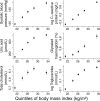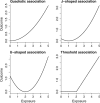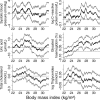Instrumental variable analysis with a nonlinear exposure-outcome relationship
- PMID: 25166881
- PMCID: PMC4222800
- DOI: 10.1097/EDE.0000000000000161
Instrumental variable analysis with a nonlinear exposure-outcome relationship
Abstract
Background: Instrumental variable methods can estimate the causal effect of an exposure on an outcome using observational data. Many instrumental variable methods assume that the exposure-outcome relation is linear, but in practice this assumption is often in doubt, or perhaps the shape of the relation is a target for investigation. We investigate this issue in the context of Mendelian randomization, the use of genetic variants as instrumental variables.
Methods: Using simulations, we demonstrate the performance of a simple linear instrumental variable method when the true shape of the exposure-outcome relation is not linear. We also present a novel method for estimating the effect of the exposure on the outcome within strata of the exposure distribution. This enables the estimation of localized average causal effects within quantile groups of the exposure or as a continuous function of the exposure using a sliding window approach.
Results: Our simulations suggest that linear instrumental variable estimates approximate a population-averaged causal effect. This is the average difference in the outcome if the exposure for every individual in the population is increased by a fixed amount. Estimates of localized average causal effects reveal the shape of the exposure-outcome relation for a variety of models. These methods are used to investigate the relations between body mass index and a range of cardiovascular risk factors.
Conclusions: Nonlinear exposure-outcome relations should not be a barrier to instrumental variable analyses. When the exposure-outcome relation is not linear, either a population-averaged causal effect or the shape of the exposure-outcome relation can be estimated.
Figures






Comment in
-
Commentary: Interpretation and sensitivity analysis for the localized average causal effect curve.Epidemiology. 2014 Nov;25(6):886-8. doi: 10.1097/EDE.0000000000000187. Epidemiology. 2014. PMID: 25265134 No abstract available.
References
-
- Herńan M, Robins J. Instruments for causal inference: an epidemiologist’s dream? Epidemiology. 2006;17:360–372. - PubMed
-
- Allison DB, Faith MS, Heo M, Kotler DP. Hypothesis concerning the U-shaped relation between body mass index and mortality. Am J Epidemiol. 1997;146:339–349. - PubMed
-
- Imbens GW, Angrist JD. Identification and estimation of local average treatment effects. Econometrica. 1994;62:467–475.
-
- Angrist J, Imbens G, Rubin D. Identification of causal effects using instrumental variables. JAMA. 1996;91:444–455.
Publication types
MeSH terms
Grants and funding
LinkOut - more resources
Full Text Sources
Other Literature Sources

